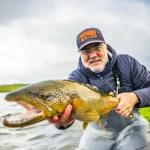The Best Anglers Never Stop Learning
The Best Anglers Never Stop Learning
The Best Anglers Never Stop Learning
The Best Anglers Never Stop Learning
I’ve had success fishing stillwater for trout when they’re feeding near the surface or hugging the bottom, but I struggle when they’re suspended in deep water—especially when they’re holding 10-20 feet down over a 40+ foot lake. A sinking line seems to pull the fly too deep, and an indicator setup doesn’t always get the right drift. What’s the best way to consistently present a fly at the right depth to these mid-column fish?

Catching trout suspended in deep stillwater is one of the most technical challenges in fly fishing because you’re working without clear current seams or bottom structure to guide your approach. The key is to precisely control depth, maintain a natural presentation, and cover water effectively without losing contact with your fly.
The first adjustment is switching to a hover, intermediate, or slow-sinking line rather than a fast-sinking or floating setup. A clear intermediate line (1-2 ips sink rate) or a hover line (neutral-density, nearly suspending in water) allows for depth precision while keeping the fly in the strike zone for longer.
Your leader setup is just as important. Instead of a standard 9-foot leader, extend it to 15-18 feet with fluorocarbon tippet to maximize depth control. Fluorocarbon sinks naturally and helps stabilize the fly at the right level.
Counting down the sink rate is critical. After the cast, let the line and fly sink in a controlled manner, using a count system (e.g., “1…2…3…”) to reach the depth where fish are holding. If trout are 15 feet down, and your line sinks at 1.5 inches per second, you need a 10-15 second countdown before retrieving.
Once the fly is in position, slow movement is the key to triggering eats. A hand-twist retrieve or a super slow figure-eight retrieve keeps the fly at depth while giving it a natural, pulsing motion. If the fish are keyed in on movement, add the occasional 1-2 inch strip, but never too aggressively—suspended trout often refuse flies that move too fast.
If trout are actively cruising at a set depth, use a “hang and drop” technique—retrieve slowly, then pause for 5-10 seconds to let the fly drop naturally, imitating an injured or resting baitfish. Many takes happen right after this drop.
When visibility is low, using a small, neutrally buoyant strike indicator can help keep the fly at the exact depth you need. A sliding indicator rig with a micro swivel and tippet ring allows for depth adjustments while avoiding excessive surface tension that could spook fish.
Precision in line selection, sink timing, and retrieve control is the difference between frustration and success when targeting suspended trout. Once you dial it in, you’ll be able to consistently fish at the exact depth where trout are holding, even in deep stillwater.
No recommended resources available.
"*" indicates required fields
Sign up for full access to the Learning Center
and all the FlyBrary Content.

payment methods accepted
Copyright © 2003 – 2025 MidCurrent LLC, All Rights Reserved.
Copyright © 2003 – 2025 MidCurrent LLC, All Rights Reserved.